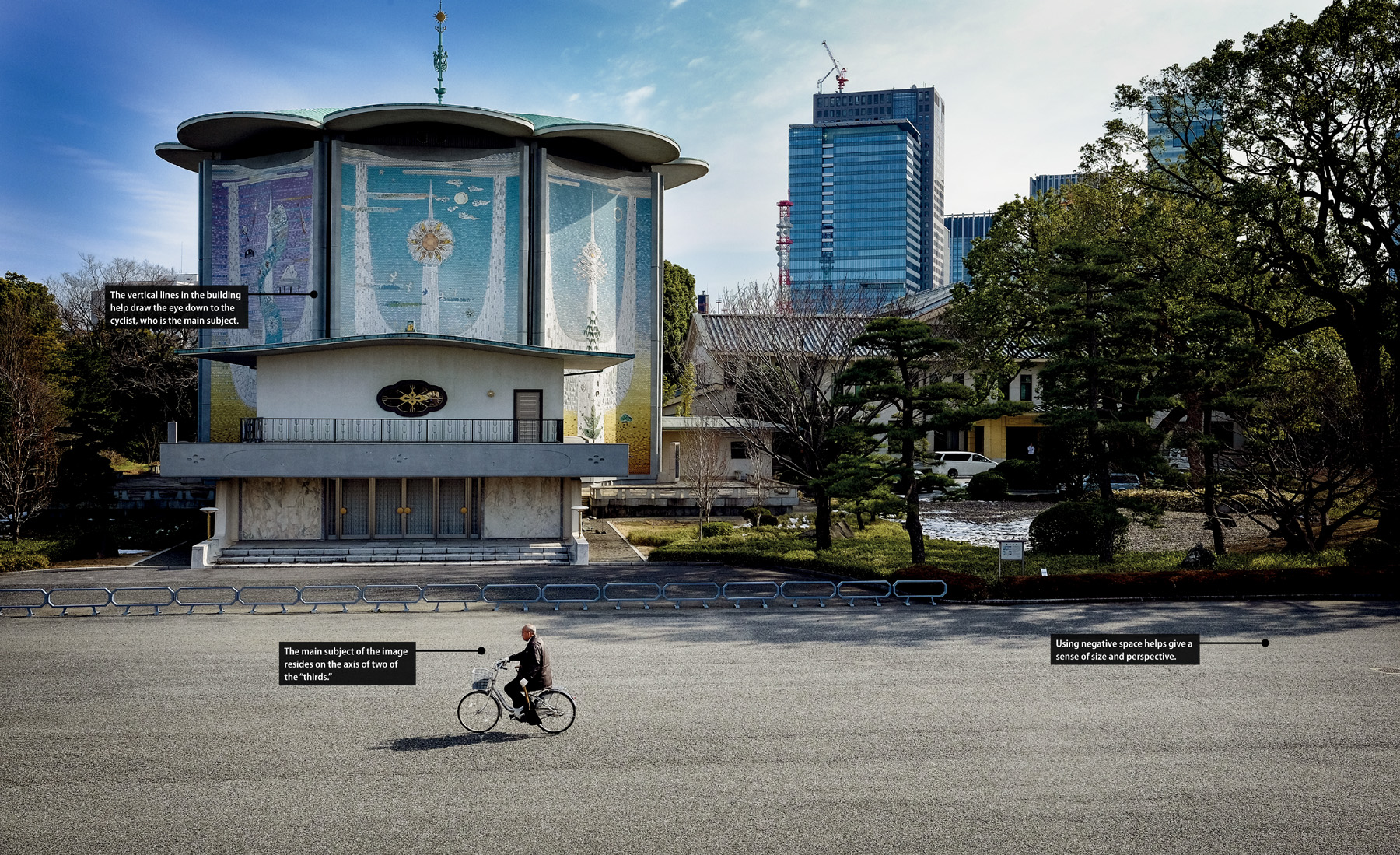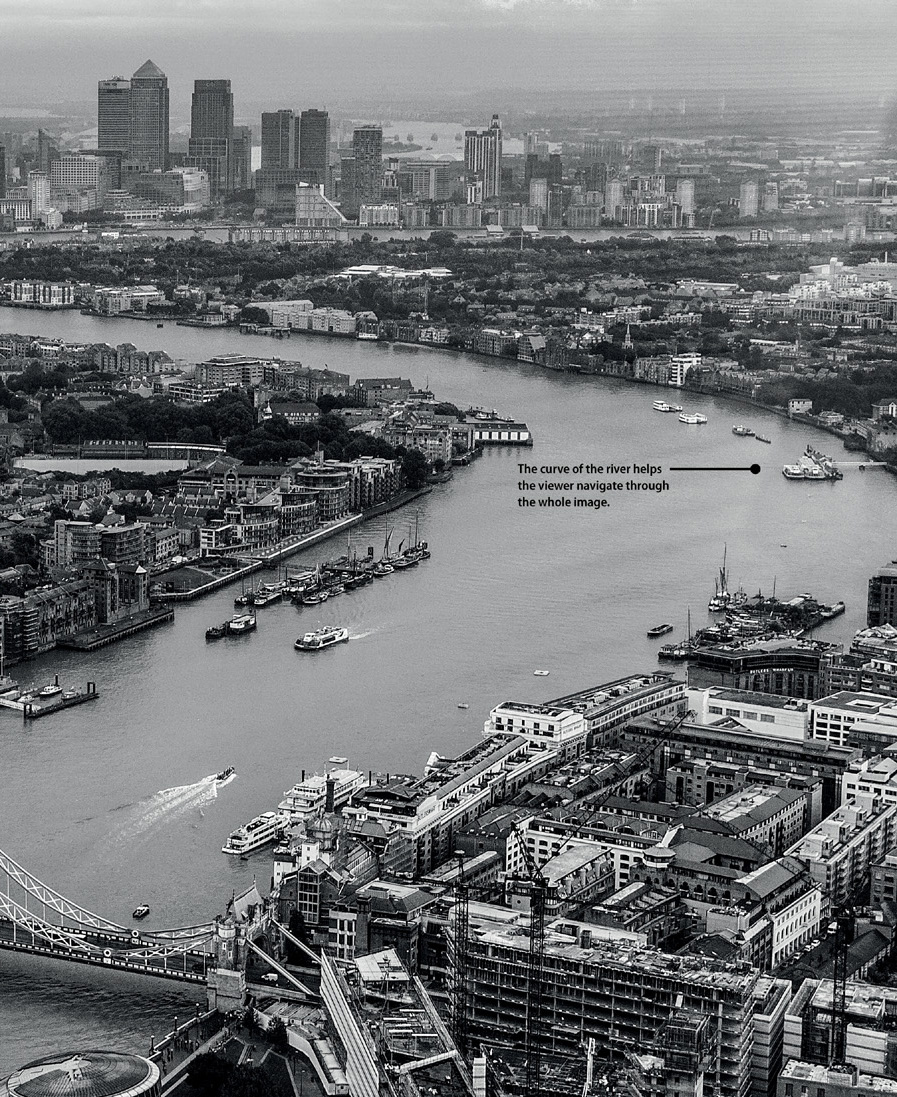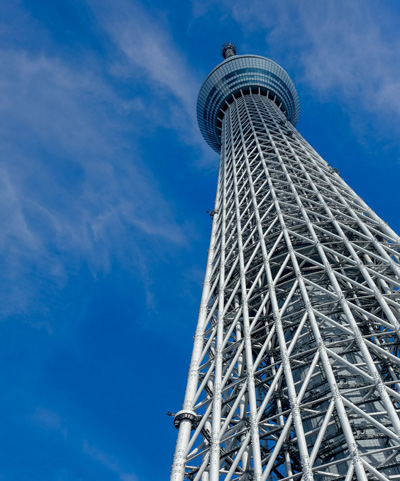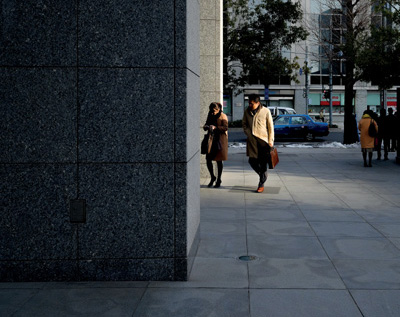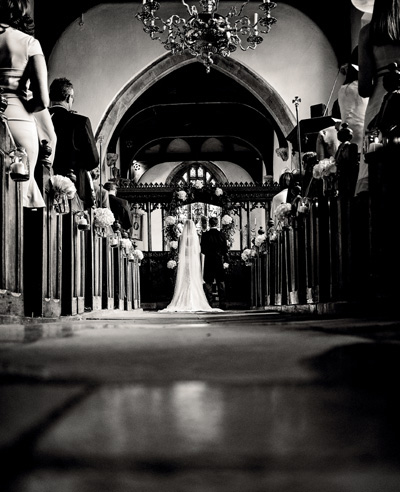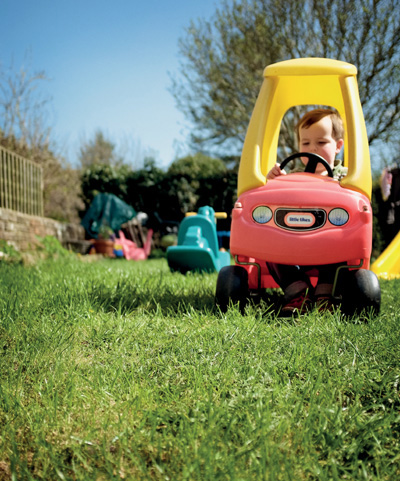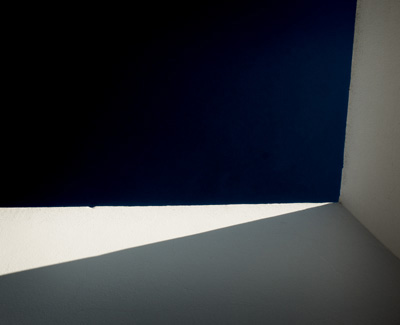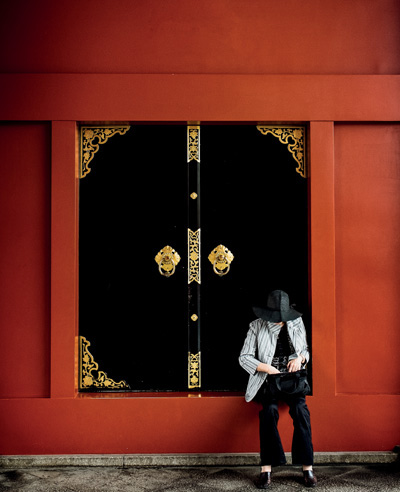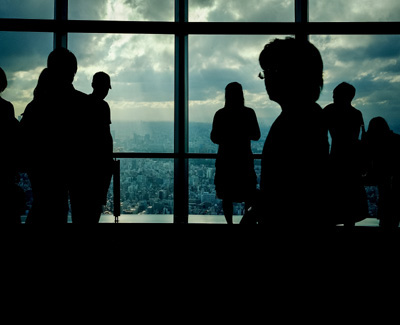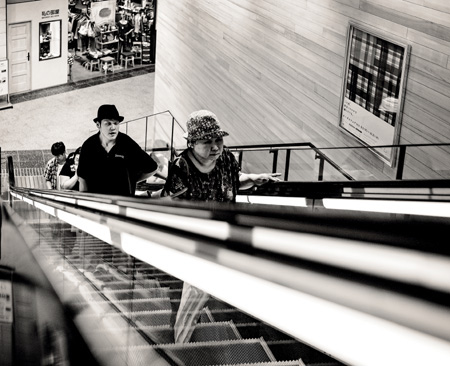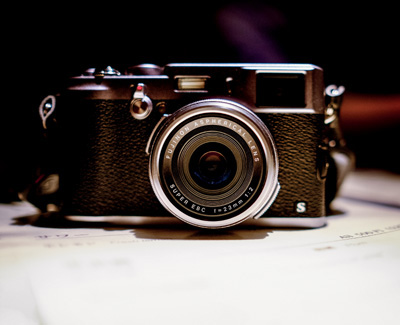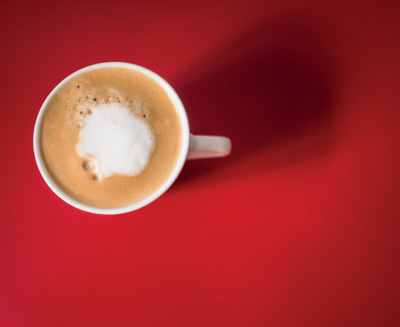8. Creative Compositions
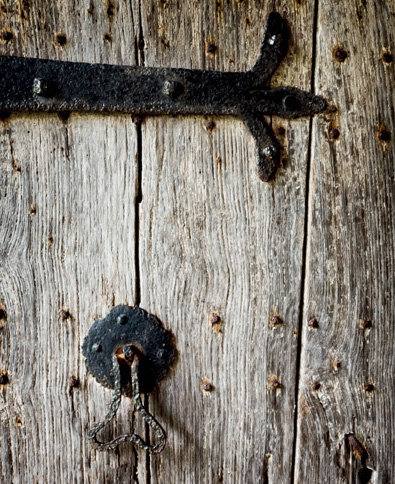
ISO 400 • 1/800 sec. • f/2 • 23mm lens
Improving your pictures with compositional flare
Creating well-composed images involves more than just using the “rule of thirds” to control to a certain extent the viewer’s experience of your images. Composition is about understanding how people view an image and how you can use those elements to your advantage to create pleasing and interesting photographs. In this chapter, we will examine some of these compositional techniques to see how you can use them to—often dramatically—improve your photographs.

Being aware of what draws the human eye can allow you to make photographs easier for a viewer to “read.” Knowing that the eye is drawn to isolated objects and contrasting areas of color allowed me to build a composition where the cyclist became the heart of the image, yet remains very small in the frame.
Poring Over the Picture
Creating a good photograph isn’t just about the camera settings—it’s also about framing the image. I wanted a cityscape shot of London and decided to get as high as possible to get a birds-eye view. However, height wasn’t the only attribute: I used the city’s natural elements, such as the skyscrapers, bridges, and rivers, to help form the overall composition of the image.
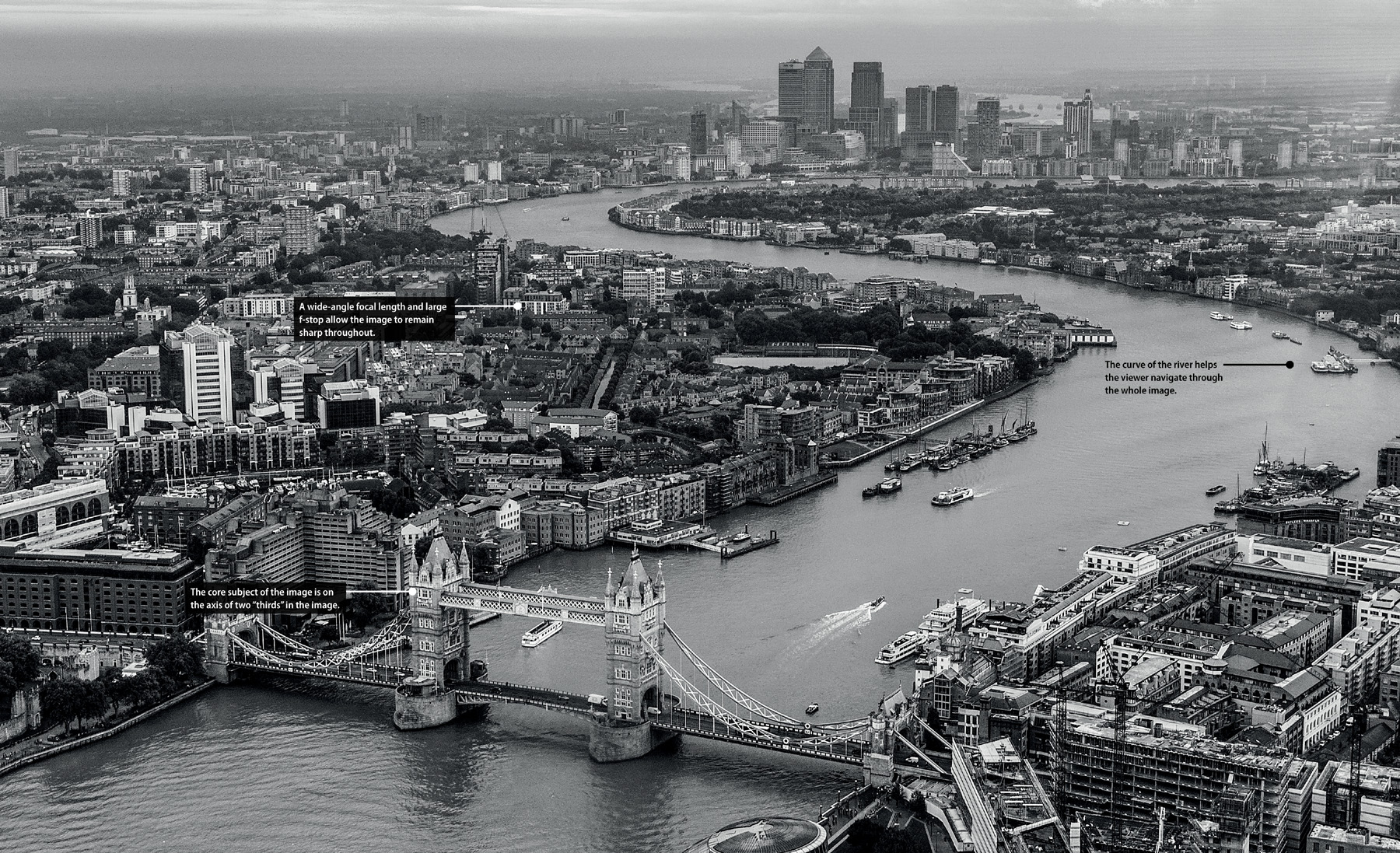
ISO 250 • 1/125 sec. • f/5.6 • 23mm lens
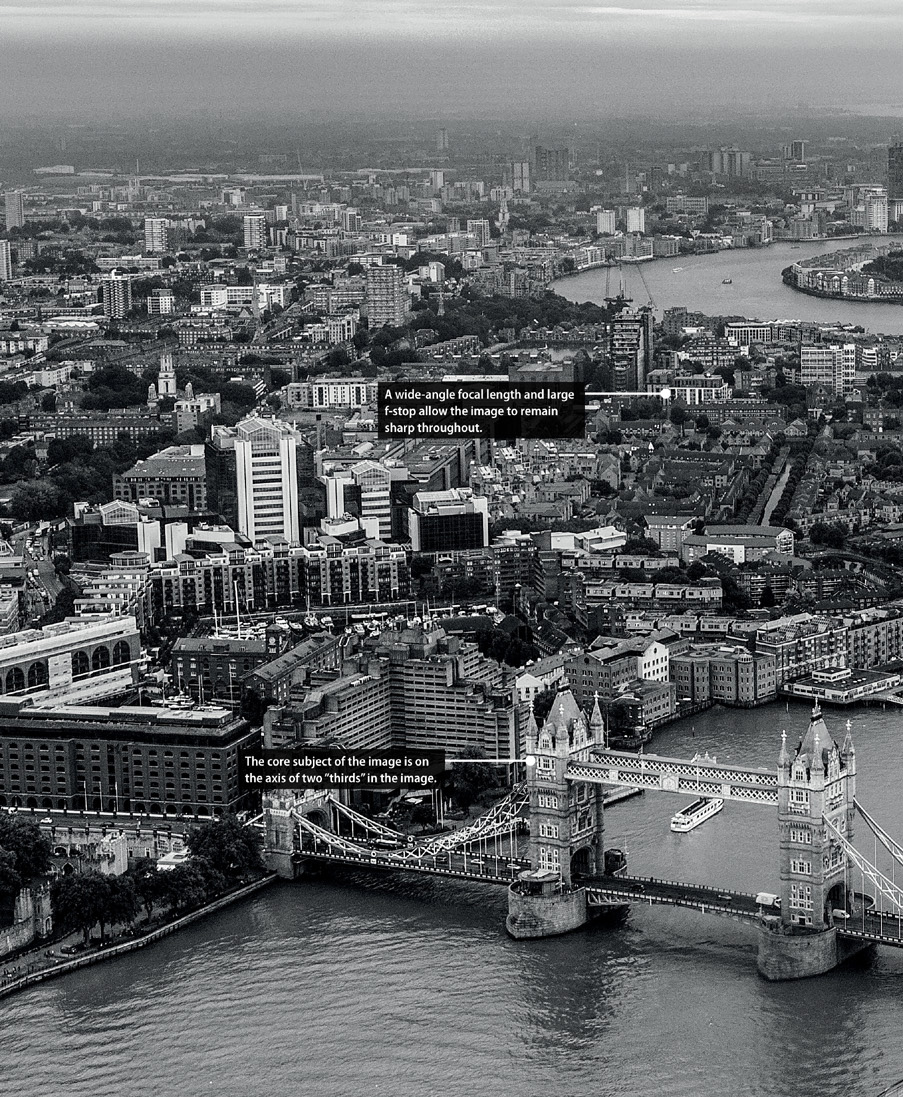
Depth of Field
One primary element of sound composition is depth of field. Selectively focusing is a great way of emphasizing your subject by controlling the depth of field, and by using a wide aperture on the X100S, you can blur the background to do just that (Figure 8.1). This allows the viewer to understand what the photographer considers the most important element within the photograph. In this example, the partial reflection in the table also enhances the composition, and the background, even if it’s blurred, provides context to the scene.
ISO 400 • 1/400 sec. • f/2 • 23mm lens
Figure 8.1 The use of a wide aperture has thrown the busy bar background out of focus and allowed me to focus exclusively on the primary subject in the image.
I used a small aperture to increase the depth of field when photographing this tower so that as much of the frame as possible would appear sharp (Figure 8.2). Although this image is quite solitary in its subject choice, other elements such as color, contrast, and negative space all play a part in the successful composition of the photograph.
ISO 200 • 1/2000 sec. • f/9 • 23mm lens
Figure 8.2 The depth of field provided by the f/9 aperture helped to emphasize the tower’s height. The negative space and contrasting color also enhance the composition by helping to draw the viewer’s eye to the subject.
Angles
Strong angular lines in an image can add to the composition, especially when they are juxtaposed to each other (Figure 8.3). This can create a tension that is different from the standard horizontal and vertical lines that we are so accustomed to seeing in more traditional photographs.
ISO 200 • 1/1000 sec. • f/5.6 • 23mm lens
Figure 8.3 The strong lines of the balconies create a dynamic composition.
Light
Perhaps the most complex yet necessary compositional element is light. Brightness (highlights) and darkness (shadows) can really come together in an image to make a dynamic compositional piece. All photographs should be a study of the presence and absence of light; a pleasing aesthetic is achieved when light and dark are balanced harmoniously (Figure 8.4).
ISO 800 • 1/500 sec. • f/8 • 23mm lens
Figure 8.4 The shaft of light illuminating the office workers and the contrast with the dark areas help lead the viewer’s eye.
Viewers’ eyes are drawn to the brightest elements in an image. This is something that painters use to their advantage on their canvases, and it’s something we, as photographers, can keep in mind, too. So it’s often best to ensure that the subject or part of the subject is in the brightest element of the frame. If something in the background or a secondary element is brighter, it can compete too heavily with the primary subject for the viewer’s attention (Figure 8.5).
ISO 800 • 1/500 sec. • f/8 • 23mm lens
Figure 8.5 The brightest element of this frame is the pile of snow. This distracts the viewer from the core subject, the man on the left of the frame. Ensuring the key subjects are brightest in the frame will result in a much better composition.
Point of View and Perspective
Sometimes the easiest way to influence your photographs is simply to change your perspective. Instead of always shooting from eye level, try moving your camera to a place where you would not normally see your subject. Try getting down very low, or at least placing the camera very low. This low angle can completely change how you view your subject and create a new interest in the scene (Figures 8.6 and 8.7).
ISO 640 • 1/125 sec. • f/2 • 19mm lens
Figure 8.6 Placing the camera at ground level gives a different perspective to an otherwise normal image.
ISO 400 • 1/755 sec. • f/2 • 23mm lens
Figure 8.7 By lying on the ground and photographing my little boy in the car, I get a more unique perspective of the scene.
Color
Color works well as a compositional tool when you have saturated colors to work with. The primary colors of red, green, and blue work especially well together, as they can be juxtaposed to create visual tension (Figure 8.8). This compositional mechanism adds drama and excitement to the scene and, when combined with other compositional elements, will aid in the creation of an excellent photograph.
ISO 200 • 1/210 sec. • f/8 • 23mm lens
Figure 8.8 Heavy blue skies against another primary color (the green grass) work well as compositional elements.
Highly contrasting or saturated colors such as white and blue, and red and yellow, can add visual appeal (Figure 8.9). Saturated colors also have a vibrancy to them that can draw the viewer into the image easily. Whether you are working with clothing, buildings, or simple everyday objects, color can be a very effective tool in your compositional arsenal.
ISO 200 • 1/125 sec. • f/16 • 23mm lens
Figure 8.9 Direct sunlight provided hard light that emphasized the contrast between the wall and the sky. The sun also created a shadow that brought some depth to the image.
I often create images that are dominated by one color, which helps with the structure and composition of the image as a whole by giving the eye a lot less information to take in before being drawn to the primary subject (Figure 8.10).
ISO 400 • 1/125 sec. • f/5.6 • 23mm lens
Figure 8.10 The façade’s deep red color against the black of the door and the lady help control how the viewer looks at the image, as the colors help lead the eye toward the central subject of the photograph.
Contrast
Areas in a photograph where light meets shadow can be very compelling to the viewer. Whether it’s a contrast of shape, color, or a silhouette, contrast can be a great vehicle for drawing the viewers’ attention to the story within the frame (Figure 8.11).
ISO 400 • 1/160 sec. • f/16 • 23mm lens
Figure 8.11 Utilizing the contrast between dark and light creates this atmospheric silhouette.
Of course, contrast doesn’t have to be about light and dark; it can be a juxtaposition of color or even shape. But, ultimately, it’s the contrast that will make an image visually interesting.
Leading Lines
Directing the viewer’s eye to the subject of an image is an import facet of compositional structure. One way to do this is to include leading lines in your images (Figure 8.12). A leading line essentially draws the viewer to the subject via elements of the image that are not necessarily part of the core story within the frame.
ISO 400 • 1/640 sec. • f/2 • 23mm lens
Figure 8.12 The leading line of the escalator rail draws the viewer’s eyes to the subjects within the image.
Backgrounds
All too often it’s easy to concentrate too much on a shot’s main subject, and to forget about how the rest of the frame affects the image. Backgrounds are a constant in every photograph, and it’s important not to let the background compete with the primary subject if it’s not intended to do so (Figure 8.13). Generally, you can shift your position or the subject to eliminate distracting backgrounds. By avoiding background clutter and distractions, you can help the viewer focus on the main subject.
ISO 400 • 1/125 sec. • f/2 • 23mm lens (macro)
Figure 8.13 Use the macro mode and a wide aperture to throw the background out of focus, preventing a cluttered background from distracting from the image’s subject.
Bringing It All Together
We’ve talked about the core elements of composition, including color, contrast, perspective, backgrounds, angles, and leading lines. In some cases, just one of those compositional elements is all that is needed to make a good image. However, if you can combine many good compositional practices into one image, you can achieve a very visually appealing result—even from a relatively simple image.
The image in Figure 8.14 works because it utilizes several key compositional elements. The red color contrasts strongly with the white of the mocha, and the background stands out with its simplicity and vivid color. Also, shooting from above the cup offers an unusual perspective, and the shadow highlights angles and leading lines directing the viewer to the primary subject of the image.
ISO 6400 • 1/45 sec. • f/2 • 23mm lens (macro)
Figure 8.14 This simple image is visually strong, as it incorporates many elements of good composition: color, contrast, clean background, and perspective.
Chapter 8 Assignments
If you apply the shooting techniques and tools that you have learned in the previous chapter to these assignments, you’ll improve your ability to incorporate good composition into your photographs. Try to experiment with all the different elements of composition and see how you can combine them to add interest to your images.
See color and lines
Take your camera for a walk around your local town. Look for contrasting colors and leading lines. Don’t worry so much about getting great shots, just look for the color and lines, and develop your eye for these details.
The ABCs of composition
Photographer Vincent Versace suggests shooting the alphabet to enhance your compositional skills. This is a tough challenge, but grab your camera and go out and look for letters. Don’t necessarily find printed letters; rather, look for objects that have the shape of letters. (Hint: Study tree branches and clouds.)
Using aperture to focus attention
Depth of field plays an important role in defining your images and establishing depth and dimension. Practice shooting wide open (perhaps close-up in macro mode) using the largest aperture available in your environment to get a good exposure.
Changing your perspective when shooting will enable the viewer to see a scene from an unusual angle. Get down very low and shoot. Then shoot the same scene from eye level. Is there any more compositional impact from the image shot down low?
Exploit the light
Go for a walk around an hour before sunset. You will likely see lovely golden light that breaks between buildings and falls in pools on the ground. Try and utilize this light to throw the focus directly onto the main subject of your image.
Combine compositional elements
See if you can create an image that pulls in three, four, or even all of the compositional elements that we have discussed in this chapter. Does the image work? If not, why?
Share your results with the book’s Flickr group!
Join the group here: flickr.com/groups/fujiX100S_fromsnapshotstogreatshots

